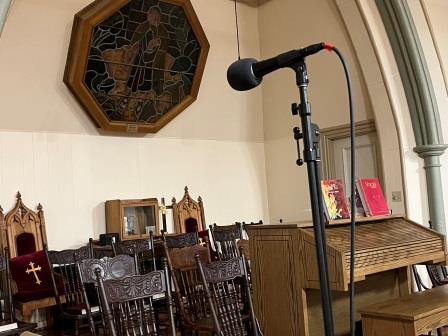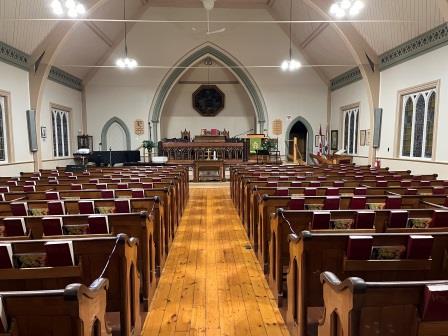January 14, 2023. One of the ongoing comments I get revolves around microphones. Either there is no microphone at an event or there is a problem with the microphones used. Quite often the sound volume is too loud, distorting what is actually being said, or there is a reverberation that sends back an echo.
A recent comment about poor sound system quality in venues in a reader’s town is typical of what is experienced:
“…A lot of venues have microphones and amplified sound. Unfortunately, typically folks don’t know how to set the sound so folks can get it. I have a hearing problem that doesn’t allow high frequencies to get through so all I get is the mumble, mumble of the low frequencies. Wearing my hearing aids just frustrates me more because there usually is so much background noise, and that’s all I get…“
I wondered what the problem was. Could it be due to poor sound equipment? Bad acoustics in the building? How the speakers were placed? Or was it nothing to do with the sound system but simply due to hearing loss? The background noise heard through hearing aids would be eliminated if the venue had a hearing loop!
I posed the question to Jack Sorensen, retired Holland College electronics instructor, who looks after the sound system at South Shore United Church in Tryon. The sound quality at the church is excellent, and yes, there is a hearing (audio) loop system in place in the sanctuary. (See https://theauralreport.wordpress.com/2018/05/26/south-shore-united-church-is-looped/)
….4 key points to set up an effective sound system…
Jack raised 4 key points to setting up an effective sound system, which are summarized here…
- Venue architecture and materials used on the walls and ceilings affect acoustics, which in turn affect the sound quality and comprehension.
- Many sound systems are set up too loud. Louder is NOT clearer.
- Place a number of speakers closer to the audience.
- Invest in a hearing loop which eliminates background noise for anyone listening through a telecoil.
…. ‘Quality sound needs to go right to the listener, not from a speaker placed far away’…
Jack explained that “…There certainly is an art in setting up sound systems. Unfortunately most venues don’t have qualified technicians, or, those they do have are younger and try to emulate modern band groups which emphasize loudness at the expense of intelligible communication…
The complexity of venue architecture and their inherent acoustic features is the main problem for setting up mics and speakers and is not always easily corrected…”

A microphone captures what the Minister says and transfers the sound into speakers placed along the walls and the hearing loop system. (Photo credit: Jack Sorensen)
“…The principle is to get quality sound going right to the listener, not from a source (speaker) located some distance away. Sound systems should be initially adjusted with a flat response, then tweaked to accommodate the building acoustics by listening to the person speaking and making it sound as close as possible to the natural sound….”

A ceiling microphone captures the choir for a richer sound experience. (Photo credit: Jack Sorensen)
Jack has placed speakers in strategic locations in the church sanctuary for an optimum sound experience. “…At our church we have six speakers located as close as possible to the congregation on the left and right sides of the church, plus at the rear. This accomplishes fairly natural sound reinforcement for most people with normal hearing ability…”

Speakers on the wall are positioned close to the church pews to provide a more natural sound experience. (Photo credit: Jack Sorensen)
“…The side aisles get the advantage of either right or left nearness. The void in the middle gets lesser sound but in both ears. The two rear speakers help to recover the sound coming directly from the person talking…”

View from the back of the church, which also has two speakers. (Photo credit: Jack Sorensen)
Jack summed up his key point, and then discussed the advantages of a hearing loop. “… In other words, the sound heard from the speakers should be as close as possible to the sound without speakers. That is why audio loops (or other systems) are so effective. Each person can have their hearing device adjusted to the characteristics of their hearing loss. As background noise is greatly diminished, it’s like talking to a person one on one, not some distance away….”
…A hearing loop delivers clarity of sound and eliminates background noise…
A hearing loop works with an existing sound system, it is NOT the sound system itself. What is a hearing loop, then? It’s a copper wire that ‘loops’ around the periphery of a room. It transmits an electromagnetic field within its loop, allowing a hearing aid or cochlear implant’s telecoil (also called a T-Coil) to function as an antenna directly linking the listener to the facility’s sound system.
Jack noted that “…The hearing loop is targeted to the hearing impaired. The challenge there is to have people actually use the system…” Ah…. the age old problem of people refusing to admit to hearing loss and therefore missing out on technology that could help recreate the sounds they no longer hear.

You can hear the difference that a hearing loop makes by listening to these two audio files, recorded in the church:
What was recorded through the microphone by the front pew of the church:
What was recorded through the hearing loop:
…Some final thoughts on acoustics….
Jack noted that “… close speakers make so much sense. We should try to emulate one-on-one conversation. Unfortunately most buildings are constructed with only aesthetics in mind. Years ago sound was considered more in building design because there was no electronic sound reinforcement available….”
So, if you are responsible for setting up an event, ask whoever is in charge of the sound to ensure that speakers are placed close to the audience, not on the stage, and invest in a quality microphone so that the person giving a presentation can be heard through the speakers.
Jack had one final observation. “…There are acoustic adjustments on some amplifiers which can be adjusted to room characteristics but this requires a good sound person to be on hand while performances are being made….”
His recommendation? “…Avoid set-and-forget situations and hire a sound professional…”
Thank you to Jack Sorensen for sharing his experience and expertise in setting up effective sound systems. Do you have a story to share? Send an email to hearpei@gmail.com, comment on the blog, or tweet to @HearPEI.
…Interested in The Aural Report?….
If you are reading this posting, but aren’t following The Aural Report blog, you are welcome to do so. See https://theauralreport.wordpress.com/ or email hearpei@gmail.com and ask for an invitation to the blog.

Why not subscribe to the Hear PEI Association Channel on YouTube? Here is the link: https://www.youtube.com/channel/UCrDqwG4tu2mmja5HwZJS3VQ
Need a hard of hearing pin? Here is the link to Hear PEI’s order form: https://form.jotform.com/201983720272252
© Daria Valkenburg
Thanks Daria for writing up this article. You’ve powerfully reinforced this excerpt from my article published several years ago:
https://canadianaudiologist.ca/issue/volume-2-issue-5-2015/breaking-the-2-meter-hearing-bubble/
” Even world class venues with the best acoustics and the best sound systems do not significantly enlarge the 2 meter “bubble” (of a hearing device). As a result, environmental noise and reverberation remain a hindrance to effective hearing for everyone, and especially for people with hearing loss.”
Thank you for your kind words, Bill, and for sharing your excellent article on sound systems. It was fortunate that Jack Sorensen was willing to share his knowledge and had the patience to explain to this non-tech person so I could write the article. Fingers crossed that at least some venues will make the necessary amendments for better hearing accessibility. All the best, Daria
As you well know, crossed fingers will do but little😀. In person advocacy and live demonstrations are needed to convince the naysayers that solutions are needed and available. Thanks Daria for all the work you do.